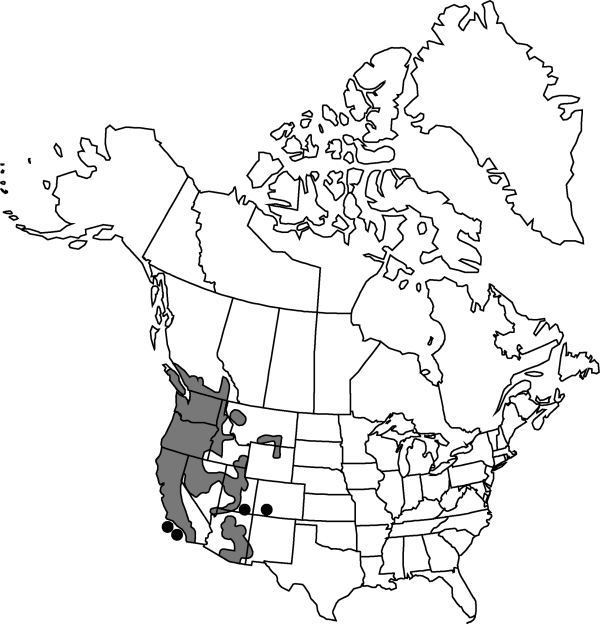Difference between revisions of "Claytonia perfoliata"
Sp. Pl. 2: 1186. 1798.
FNA>Volume Importer |
imported>Volume Importer |
||
| Line 8: | Line 8: | ||
}} | }} | ||
|common_names=Miner’s-lettuce | |common_names=Miner’s-lettuce | ||
| + | |special_status={{Treatment/ID/Special_status | ||
| + | |code=F | ||
| + | |label=Illustrated | ||
| + | }} | ||
|basionyms= | |basionyms= | ||
|synonyms={{Treatment/ID/Synonym | |synonyms={{Treatment/ID/Synonym | ||
| Line 24: | Line 28: | ||
-->{{Treatment/Body | -->{{Treatment/Body | ||
| − | |distribution= | + | |distribution=B.C.;Ariz.;Calif.;Colo.;Idaho;Mont.;N.Mex.;Nev.;Oreg.;Utah;Wash.;Wyo.;Central America (Guatemala);adventive in Europe;Pacific Islands (New Zealand). |
|discussion=<p>Subspecies 3 (3 in the flora).</p> | |discussion=<p>Subspecies 3 (3 in the flora).</p> | ||
|tables= | |tables= | ||
| Line 62: | Line 66: | ||
|basionyms= | |basionyms= | ||
|family=Portulacaceae | |family=Portulacaceae | ||
| − | |distribution= | + | |distribution=B.C.;Ariz.;Calif.;Colo.;Idaho;Mont.;N.Mex.;Nev.;Oreg.;Utah;Wash.;Wyo.;Central America (Guatemala);adventive in Europe;Pacific Islands (New Zealand). |
|reference=None | |reference=None | ||
|publication title=Sp. Pl. | |publication title=Sp. Pl. | ||
|publication year=1798 | |publication year=1798 | ||
| − | |special status= | + | |special status=Illustrated |
| − | |source xml=https:// | + | |source xml=https://bibilujan@bitbucket.org/aafc-mbb/fna-data-curation.git/src/bb6b7e3a7de7d3b7888a1ad48c7fd8f5c722d8d6/coarse_grained_fna_xml/V4/V4_943.xml |
|genus=Claytonia | |genus=Claytonia | ||
|species=Claytonia perfoliata | |species=Claytonia perfoliata | ||
Revision as of 23:21, 27 May 2020
Plants annual, with minute, tuberous bodies; periderm absent. Stems 5–50 cm. Leaves: basal leaves in suberect to erect, seldom flattened rosettes, petiolate, 1–30 cm, blade often with weak red pigmentation, broadly rhombic to deltate or reniform, 1–7 × 0.5–5(–6) cm, apex obtuse to apiculate, mucro 1–3 mm; cauline leaves sessile, blade perfoliate or cleft or notched, 10 cm diam. or less. Inflorescences 1-bracteate; bract leaflike, 0.5–15 mm. Flowers 3–10 mm; sepals 1.5–4 mm; petals pink or white, 2–5 mm; ovules 3. Seeds 2–5 mm, shiny and smooth; elaiosome 1–3 mm. 2n = 12, 24, 36, 48, 60.
Distribution

B.C., Ariz., Calif., Colo., Idaho, Mont., N.Mex., Nev., Oreg., Utah, Wash., Wyo., Central America (Guatemala), adventive in Europe, Pacific Islands (New Zealand).
Discussion
Subspecies 3 (3 in the flora).
Selected References
None.
Lower Taxa
Key
| 1 | Basal leaf rosettes erect, 20-50 cm; cauline leaf pairs connate into perfoliate discs, blade margins entire; seeds 3-5 mm | Claytonia perfoliata subsp. perfoliata |
| 1 | Basal leaf rosettes suberect to flattened, 2-30 cm; cauline leaf pairs perfoliate, blade margins notched or deeply cleft; seeds 2-4 mm | > 2 |
| 2 | Basal leaf blades ovate to broadly rhombic, apex obtuse; leaf blades often beet red, gray-green, or purplish; epidermal gas pockets easily seen in field; seeds 3-4 mm | Claytonia perfoliata subsp. intermontana |
| 2 | Basal leaf blades deltate, apex apiculate; leaf blades mostly green; not beet red; epidermal gas pockets usually not visible (except in populations of California Transverse Ranges); seeds 2-3 mm | Claytonia perfoliata subsp. mexicana |